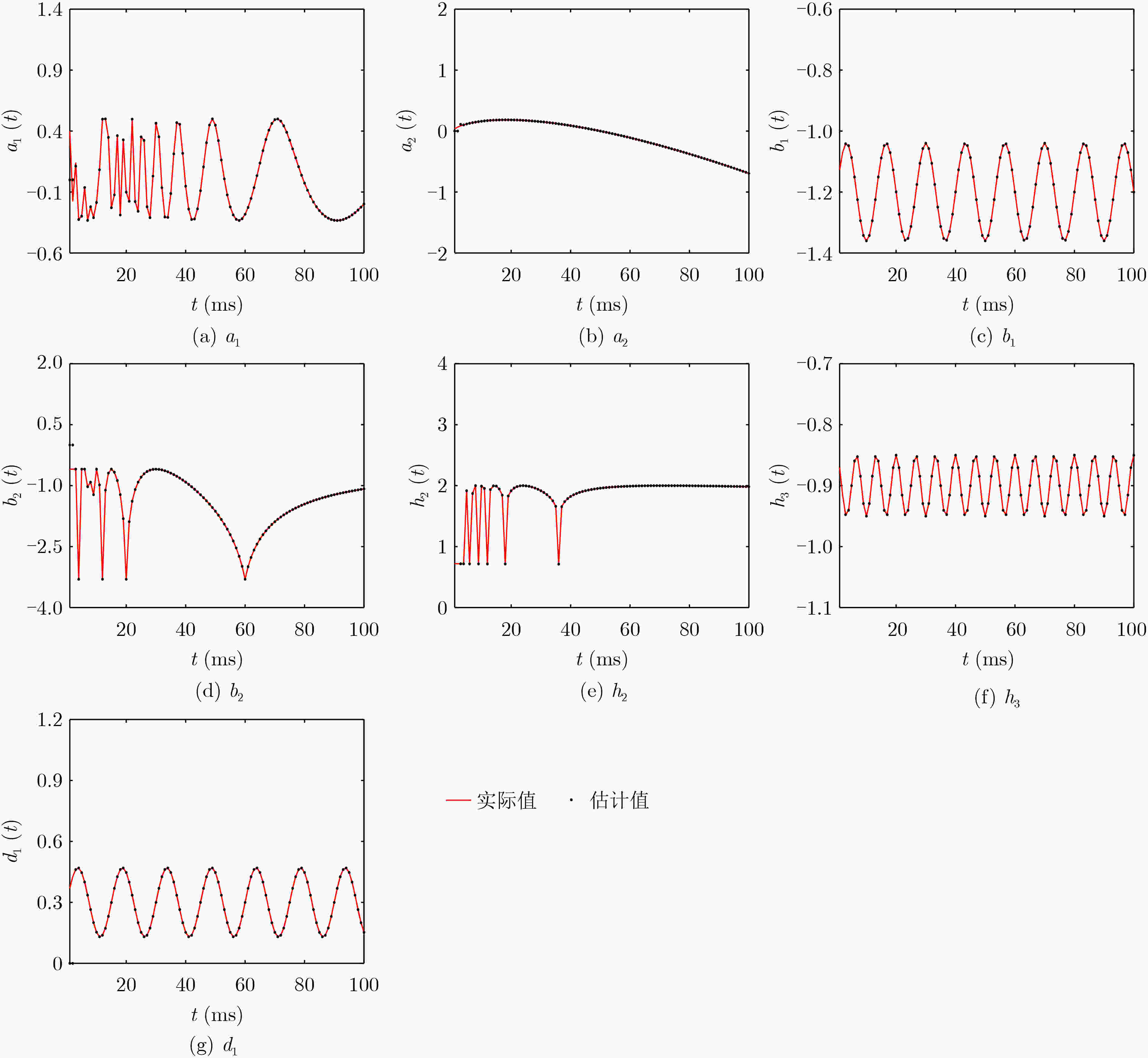Weighted Learning Identification Method for Hammerstein Nonlinear Time-varying Systems
-
摘要: 针对有限区间哈默斯坦(Hammerstein)非线性时变系统,该文提出一种加权迭代学习算法用以估计系统时变参数。首先将Hammerstein系统输入非线性部分进行多项式展开,采用迭代学习最小二乘算法辨识系统的时变参数。为了防止数据饱和,采用带遗忘因子的迭代学习最小二乘算法,进而引入权矩阵,采用加权迭代学习最小二乘算法改进系统跟踪误差,以提高辨识精度。该文分别给出3种算法的推导过程并进行仿真验证。结果表明,与迭代学习最小二乘算法和带遗忘因子迭代学习最小二乘算法相比,加权迭代学习最小二乘算法具有辨识精度高、跟踪误差小以及迭代次数少等优点。Abstract: For Hammerstein nonlinear time-varying systems running repeatedly on finite intervals, a weighted iterative learning algorithm is proposed to estimate the time-varying parameters involved in the system dynamics. The nonlinear input part of the Hammerstein system is tackled based on polynomial expansion, and the iterative learning least square algorithm is given for the time-varying parameter identification. In order to prevent data saturation, an iterative learning least squares algorithm with forgetting factor is proposed for reducing the system tracking error and improving the identification accuracy; A weighted iterative learning least squares algorithm is further presented by introducing the weight matrix. The derivations of the three algorithms are given in detail. The simulation results demonstrate the effectiveness of the proposed learning algorithms, and in comparison with iterative learning least squares algorithm, the modified one sreach high identification accuracy and need fewer iterations.
-
表 1 采用加权迭代学习最小二乘算法进行参数估计流程图
输入:重复激励的一组数列 输出:堆积的输出向量${{\boldsymbol{Y}}_k}(t)$ (1) 对于所有的$t = {\text{0,1} },\cdots,N$,给定参数估计的初始值
${\hat \theta _{ - 1}}(t)$=0,迭代所需的${\hat v_k}(t)$,$ {q_1} $及${r_1}$,并置$k = {\text{0}}$;(2) While $k \le {K_{ {\text{max} } } }$(${K_{{\text{max}}}}$为最大迭代次数) (3) for each $t \in [0,N]$ (4) 在第$k$次重复运行时,采集输入数据${u_k}(t)$,计算输出
数据${y_k}(t)$;(5) 计算${{\boldsymbol{Q}}_k}$和${\boldsymbol{\varPhi} } _k^{}(t)[{\hat {\boldsymbol{\phi}} _k}(t)]$; (6) 通过式(46)计算得出${\hat {\boldsymbol{\theta}} _k}(t)$; (7) 利用式(23)更新${\hat v_k}(t)$; (8) End (9) 检验迭代停止条件,满足则停止;否则置$k = k + {\text{1}}$,并回到
第3步;(10) End -
[1] WANG Dongqing, ZHANG Shuo, GAN Min, et al. A novel EM identification method for hammerstein systems with missing output data[J]. IEEE Transactions on Industrial Informatics, 2020, 16(4): 2500–2508. doi: 10.1109/TII.2019.2931792 [2] CERONE V, RAZZA V, and REGRUTO D. One-shot set-membership identification of Generalized Hammerstein–Wiener systems[J]. Automatica, 2020, 118: 109028. doi: 10.1016/j.automatica.2020.109028 [3] LYU Bensheng, LI Jia, and LI Feng. Neuro-fuzzy based identification of Hammerstein OEAR systems[J]. Computers & Chemical Engineering, 2020, 141: 106984. doi: 10.1016/j.compchemeng.2020.106984 [4] 贾立, 李训龙. Hammerstein模型辨识的回顾及展望[J]. 控制理论与应用, 2014, 31(1): 1–10. doi: 10.7641/CTA.2014.30478JIA Li and LI Xunlong. Identification of Hammerstein model: Review and prospect[J]. Control Theory &Applications, 2014, 31(1): 1–10. doi: 10.7641/CTA.2014.30478 [5] WESTWICK D and VERHAEGEN M. Identifying MIMO Wiener systems using subspace model identification methods[J]. Signal Processing, 1996, 52(2): 235–258. doi: 10.1016/0165-1684(96)00056-4 [6] LOVERA M, GUSTAFSSON T, and VERHAEGEN M. Recursive subspace identification of linear and non-linear Wiener state-space models[J]. Automatica, 2000, 36(11): 1639–1650. doi: 10.1016/S0005-1098(00)00103-5 [7] JALALEDDINI K and KEARNEY R E. Subspace identification of SISO hammerstein systems: Application to stretch reflex identification[J]. IEEE Transactions on Biomedical Engineering, 2013, 60(10): 2725–2734. doi: 10.1109/TBME.2013.2264216 [8] GOETHALS I, PELCKMANS K, SUYKENS J A K, et al. Subspace identification of hammerstein systems using least squares support vector machines[J]. IEEE Transactions on Automatic Control, 2005, 50(10): 1509–1519. doi: 10.1109/TAC.2005.856647 [9] BAI Erwei. An optimal two-stage identification algorithm for Hammerstein-Wiener nonlinear systems[J]. Automatica, 1998, 34(3): 333–338. doi: 10.1016/S0005-1098(97)00198-2 [10] CHANG F H I and LUUS R. A noniterative method for identification using Hammerstein model[J]. IEEE Transactions on Automatic Control, 1971, 16(5): 464–468. doi: 10.1109/TAC.1971.1099787 [11] WANG Dongqing and DING Feng. Least squares based and gradient based iterative identification for Wiener nonlinear systems[J]. Signal Processing, 2011, 91(5): 1182–1189. doi: 10.1016/j.sigpro.2010.11.004 [12] WANG Dongqing, FAN Qiuhua, and MA Yan. An interactive maximum likelihood estimation method for multivariable Hammerstein systems[J]. Journal of the Franklin Institute, 2020, 357(17): 12986–13005. doi: 10.1016/j.jfranklin.2020.09.005 [13] GREBLICKI W and PAWLAK M. The weighted nearest neighbor estimate for Hammerstein system identification[J]. IEEE Transactions on Automatic Control, 2019, 64(4): 1550–1565. doi: 10.1109/TAC.2018.2866463 [14] MZYK G and WACHEL P. Kernel-based identification of Wiener–Hammerstein system[J]. Automatica, 2017, 83: 275–281. doi: 10.1016/j.automatica.2017.06.038 [15] GIORDANO G, GROS S, and SJÖBERG J. An improved method for Wiener-Hammerstein system identification based on the Fractional Approach[J]. Automatica, 2018, 94: 349–360. doi: 10.1016/j.automatica.2018.04.046 [16] SUNG S W. System identification method for Hammerstein processes[J]. Industrial & Engineering Chemistry Research, 2002, 41(17): 4295–4302. doi: 10.1021/ie0109206 [17] JIA Li, LI Xunlong, and CHIU M S. Correlation analysis based MIMO neuro-fuzzy Hammerstein model with noises[J]. Journal of Process Control, 2016, 41: 76–91. doi: 10.1016/j.jprocont.2015.11.006 [18] DING Feng, SHI Yang, and CHEN Tongwen. Gradient-based identification methods for hammerstein nonlinear ARMAX models[J]. Nonlinear Dynamics, 2006, 45(1/2): 31–43. doi: 10.1007/s11071-005-1850-z [19] REN Biying, XIE Chenxue, SUN Xiangdong, et al. Parameter identification of a lithium-ion battery based on the improved recursive least square algorithm[J]. IET Power Electronics, 2020, 13(12): 2531–2537. doi: 10.1049/iet-pel.2019.1589 [20] ZHANG Bo, TANG Yinggan, and LU Yao. Identification of linear time-varying fractional order systems using block pulse functions based on repetitive principle[J]. ISA Transactions, 2022, 123: 218–229. [21] 孙明轩, 毕宏博. 学习辨识: 最小二乘算法及其重复一致性[J]. 自动化学报, 2012, 38(5): 698–706. doi: 10.3724/SP.J.1004.2012.00698SUN Mingxuan and BI Hongbo. Learning identification: Least squares algorithms and their repetitive consistency[J]. Acta Automatica Sinica, 2012, 38(5): 698–706. doi: 10.3724/SP.J.1004.2012.00698 [22] SONG Fazhi, LIU Yang, WANG Xianli, et al. Enhancing accuracy and numerical stability for repetitive time-varying system identification: An iterative learning approach[J]. IEEE Access, 2020, 8: 25679–25690. doi: 10.1109/ACCESS.2020.2966300 [23] LIU Nanjun and ALLEYNE A. Iterative learning identification for linear time-varying systems[J]. IEEE Transactions on Control Systems Technology, 2016, 24(1): 310–317. doi: 10.1109/TCST.2015.2424374 [24] DING Feng, XU Ling, MENG Dandan, et al. Gradient estimation algorithms for the parameter identification of bilinear systems using the auxiliary model[J]. Journal of Computational and Applied Mathematics, 2020, 369: 112575. doi: 10.1016/j.cam.2019.112575 [25] DING Jie, CAO Zhengxin, CHEN Jiazhong, et al. Weighted parameter estimation for hammerstein nonlinear ARX systems[J]. Circuits, Systems, and Signal Processing, 2020, 39(4): 2178–2192. doi: 10.1007/s00034-019-01261-4 -






 下载:
下载:





 下载:
下载:
